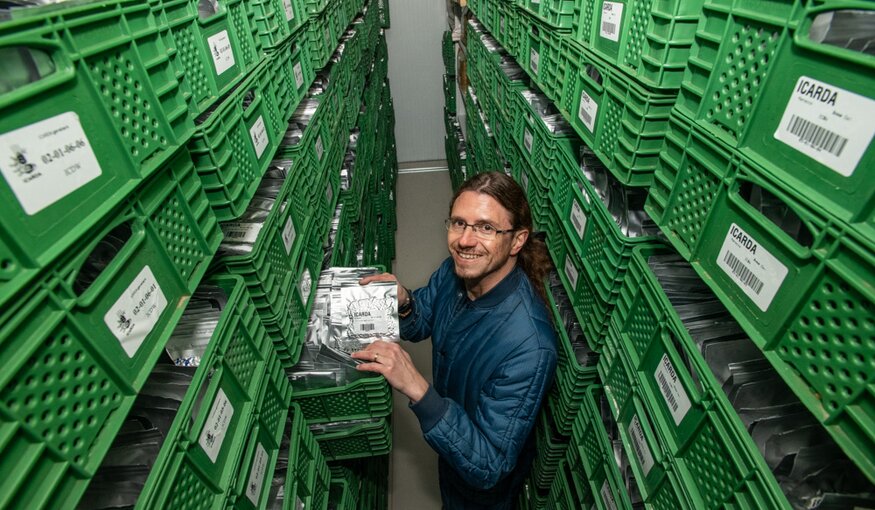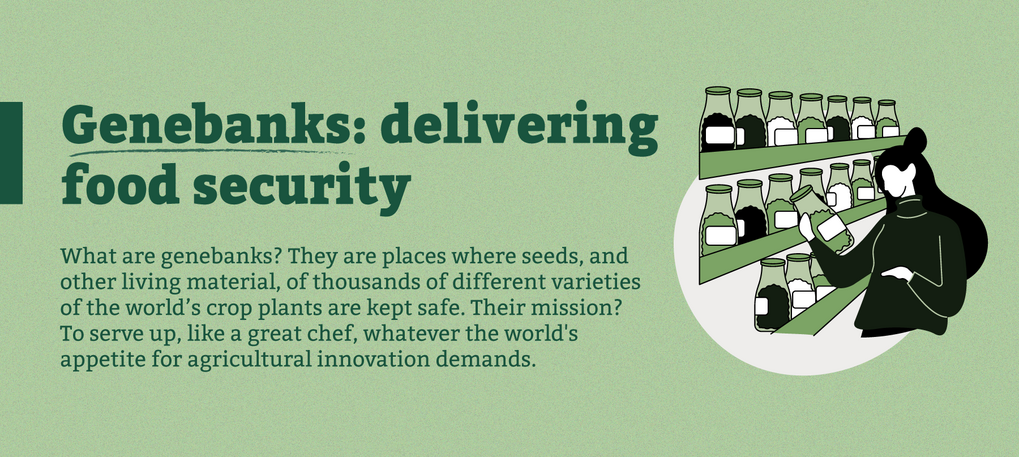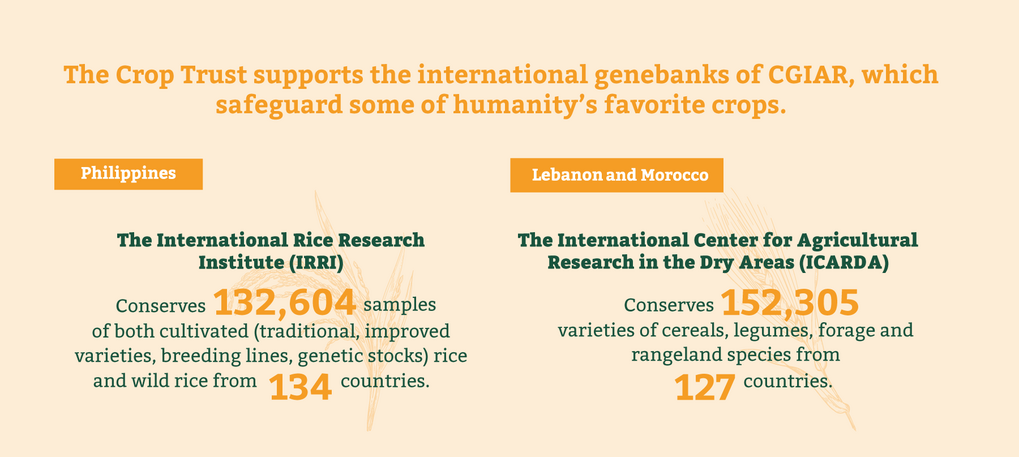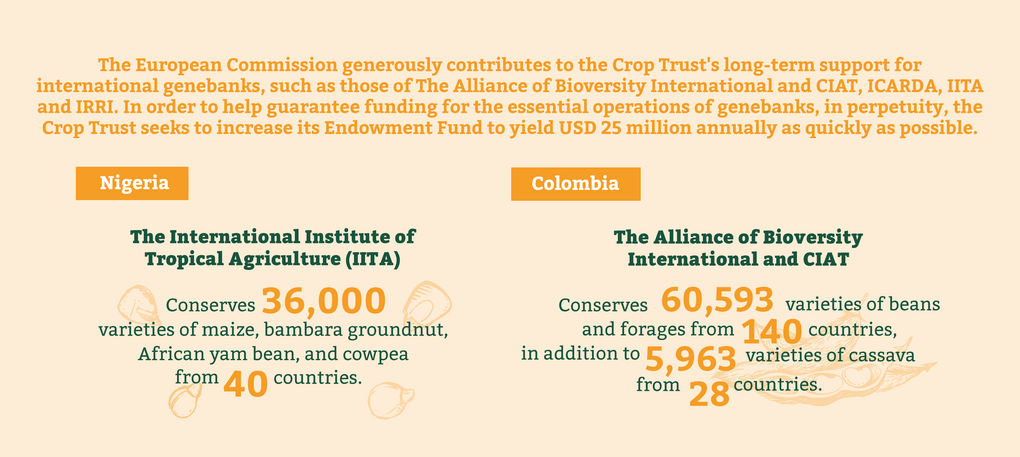A Coldroom for Every Crop

Genebank Manager Athanasios Tsivelikas in base collection cold room, Rabat, Morocco. Photo: Michael Major/Crop Trust
13 October 2023
Even on World Food Day, when the world is abuzz with talk about the future of humanity and the planet, it’s easy to take seeds for granted. But without seeds, we wouldn’t have food.
Saving seeds is in fact what will help us overcome hunger and provide a healthier, more balanced diet for all.
But seeds, just like all living organisms, need TLC: tender loving care. That’s what genebanks provide. And the Crop Trust, with financial support from the European Commission, is helping four CGIAR genebanks take good care of their seeds.

Genebanks safeguard an astonishing array of the diversity within crops, from barley to beans to rice. These treasure troves link our past, present, and future. “Diversity is what provides resilience to modern crops, so they can tackle both current and future agricultural challenges,” says Thanos Tsivelikas, the manager of the genebank of the International Center for Agricultural Research in the Dry Areas (ICARDA) in Morocco.

Within the walls of genebanks’ coldrooms you can find thousands of seed samples of crop varieties and crop wild relatives, kept safe for posterity.
ICARDA, for example, has 152,305 samples of cereals, legumes, forage and rangeland species in its genebank from 127 countries. The International Rice Research Institute (IRRI) holds 132,604 samples of both cultivated and wild rice from 134 countries. The Alliance of Bioversity International and the International Center for Tropical Agriculture (CIAT) conserves 60,593 types of beans and forages from 140 countries, in addition to 5,963 varieties of cassava from 28 countries. IITA, the International Institute for Tropical Agriculture, with which the Crop Trust recently signed a long-term funding agreement, curates the world’s largest cowpea collection of 18,000 samples, in addition to thousands of varieties of other crops.
But the mission of a modern-day genebank extends beyond conservation. They must not only conserve their collections but serve as dynamic hubs of innovation by distributing seeds, sharing data and collaborating with researchers and farmers around the world to unlock the full potential of crop diversity. Each of the samples in a genebank – or accessions, as a genebank manager would call them – could prove vital for food security, resilience and adaptation in the face of climate change and other challenges by providing plant breeders with the traits they need to help farmers solve their problems.

And it’s not just about seeds. “Much of our cassava collection is grown in vitro. That means we keep them as plantlets in test tubes rather than seeds,” says Peter Wenzl, the leader of the Genetic Resources Program at The Alliance of Bioversity International and the International Center for Tropical Agriculture (CIAT). “Every one to two years, we must replace the plantlets because they don't last forever. We’ve got almost 6,000 types of cassava, so that’s a big task!”
Genebanks require reliable funding to carry out this essential work effectively. Shortfalls in funding such crucial activities as seed collecting, viability testing, regeneration, characterization, evaluation and distribution leads to backlogs, imperils diversity, and holds back the use of the collection. Proper funding enables genebanks to invest in modern technologies, maintain state-of-the-art facilities and implement efficient data management systems.
Adequate funding also allows genebanks to engage in research and pre-breeding programs, accelerating the development of improved crop varieties that are resilient to emerging challenges such as pests, diseases, and the changing climate.
“The collections in our genebanks will also help mitigate climate change,” says Peter. “For example, we’re screening thousands of forage varieties from our genebank for compounds that might inhibit the production of methane in cattle stomachs. This could reduce emissions of greenhouse gases.”
With the financial freedom to invest in cutting-edge research, genebanks can act as innovation hubs, providing farmers with the tools they need to adapt and thrive in an ever-changing world.
Genebanks must also share their wealth of knowledge and resources with the broader agricultural research community. Collaboration and knowledge-sharing are essential for harnessing the full potential of crop diversity and driving transformative change in agrifood systems.
In order to help guarantee funding for the essential operations of genebanks, in perpetuity, the Crop Trust seeks to increase as quickly as possible its Endowment Fund to yield USD 25 million annually. The European Commission generously contributes to the Crop Trust’s long-term support for international seedbanks, such as those of The Alliance of Bioversity International and CIAT, ICARDA, IITA and IRRI.
Let’s make sure that all of the world’s crops have a coldroom of their own, and guarantee more secure, prosperous and diverse agricultural landscapes.
